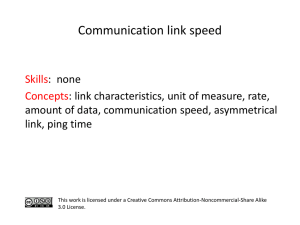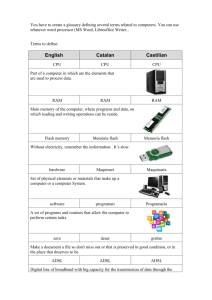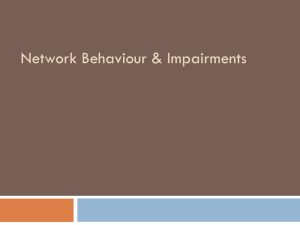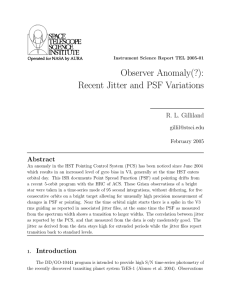Course overview
advertisement
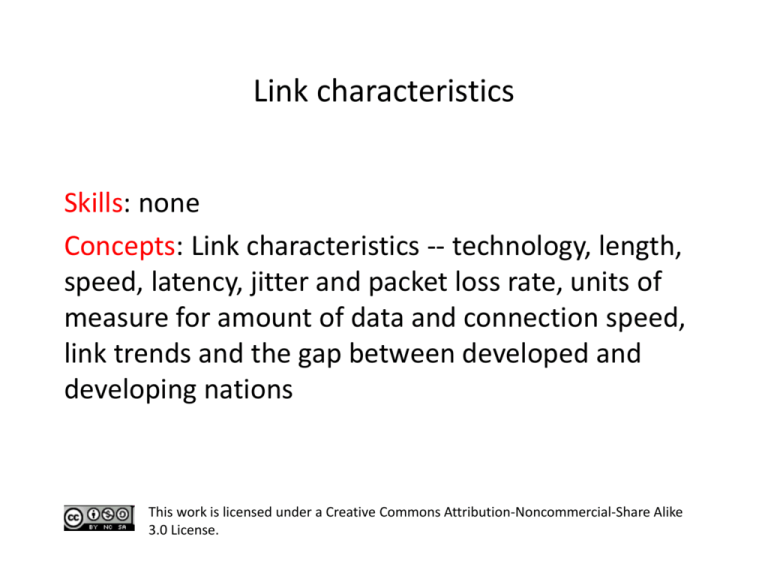
Link characteristics Skills: none Concepts: Link characteristics -- technology, length, speed, latency, jitter and packet loss rate, units of measure for amount of data and connection speed, link trends and the gap between developed and developing nations This work is licensed under a Creative Commons Attribution-Noncommercial-Share Alike 3.0 License. Where does this topic fit? • Internet concepts – Applications – Technology (communication) – Implications • Internet skills – Application development – Content creation – User skills Link characteristics Computer 2 Computer 1 Link technology Link length Link speed Latency, jitter and packet loss rate Wireless connection technologies Terrestrial radio Satellite radio Wire-line connection technologies Copper, twisted pair (electronic) Copper, coaxial cable (electronic) Fiber (optical) Only use wireless links when a wired connection is not convenient or possible. Link characteristics Computer 1 Computer 2 Link technology Link length Link speed Latency, jitter and packet loss rate Link length Link characteristics Computer 1 Computer 2 Link technology Link length Link speed Latency, jitter and packet loss rate What are some unit of measure for … Length? Weight? Data? 0101010101001011010 0101110010101010100 1010101000101010101 0101010100101010010 1010100100100100101 0101001000101010101 1101001010010101010 Units of measure for quantity inches, meters, millimeters, miles, nanometers, light years, etc. bits, bytes, kilobytes, kilobits, terabits, megabits, gigabytes, etc. pounds, ounces, grams, kilograms, tons, nanograms, milligrams, etc. 0101010101001011010 0101110010101010100 1010101000101010101 0101010100101010010 1010100100100100101 0101001000101010101 1101001010010101010 What are some units of measure for time? Units of measure for time hours, days, weeks, years, centuries, seconds, microseconds, nanoseconds, and so forth Rate = quantity per unit of time Distance traveled per unit of time Units of measure for data transmission rate Time ? Amount of data ? Transmission rate ? Transmission rate = amount of data per unit of time Units of measure for data transmission rate Time Amount of data Transmission rate second bit ? Transmission rate = amount of data per unit of time Units of measure for data transmission rate Time Amount of data Transmission rate second bit bits per second Transmission rate = amount of data per unit of time The Internet Home Link characteristics Computer 1 Computer 2 Link technology Link length Link speed Latency, jitter and packet loss rate Latency – the time for the first packet to arrive Jitter Distance (miles) P1 (ms) P2 (ms) P3 (ms) P4 (ms) Avg. (ms) Jitter (st dev) Santiago Chile 5,585 412 346 228 225 303 92.08 Oxford England 5,408 195 194 195 193 194 .96 Which has the lowest jitter? Packet loss rate Service level agreement Speed and ping tests The link from your home to the Internet ? Home LAN The Internet LAN router ISP router Typical speed examples Link Typical speed residential DSL link 3 mb/s residential cable link 10 mb/s residential fiber link 25 mb/s residential satellite 1 mb/s Link from our campus to CSU net 1 gb/s intercity fiber 10 gb/s undersea fiber cable 1 tb/s Global view PingER at Stanford University http://bit.ly/mnruYf Steadily faster International traffic Intercontinental traffic flows Summary Computer 1 Computer 2 Self-study questions 1. 2. 3. 4. 5. 6. 7. 8. 9. 10. 11. 12. 13. 14. 15. 16. We discussed several characteristics of a communication link. Without looking back, do you recall what they were? Name two units of measure for each of the following: • Weight • Length • Rate at which you run • Amount of data • Rate of data transmission The general form of a unit of measure for velocity is distance/time. What is the general form of a unit of measure for data transmission speed? What unit of measure would you use for a quantity of water? What unit of measurement would you use for the rate at which water flows through a hose? When you walk, you typically travel at rate of about 4 miles per hour. Convert that to miles per second. When you walk, you typically travel at rate of about 4 miles per hour. Convert that to feet per second. How many bits in a megabyte? How long would it take to transmit a 100 megabit file over a 100 megabit/second link? How long would it take to transmit a 100 megabit file over a 10 megabit/second link? How long would it take to transmit a 100 megabit file over a one gigabit/second link? How long would it take to transmit a 100 megabyte file over a 100 megabit/second link? How long would it take to transmit a 100 megabit file over a 100 megabyte/second link? How long would it take to transmit a 132 megabyte file over a 12 megabit/second link? What are the speed, technology, length and monthly cost of the link from your home to your Internet service provider? We saw that Internet links are often asymmetric – faster in one direction than the other. Why is the transmission rate from your ISP to your home faster than the other direction? Resources Test ping times: http://pingtest.net Test data transmission rate: http://speedtest.net A more detailed link test with hints to improve performance by adjusting TCP parameters: http://ndt.anl.gov Current data on Verizon network performance: http://www.verizonbusiness.com/about/network/latency/ The 2010 Stanford report on Internet performance: http://www.slac.stanford.edu/xorg/icfa/icfa-net-paper-jan10/reportjan10.doc Aladdin Nassar, Worldwide Inventory of Last-mile Bandwidths & Network Latencies: http://velocityconf.com/velocity2010/public/schedule/detail/14075 Project PingER: http://www-iepm.slac.stanford.edu/pinger/
